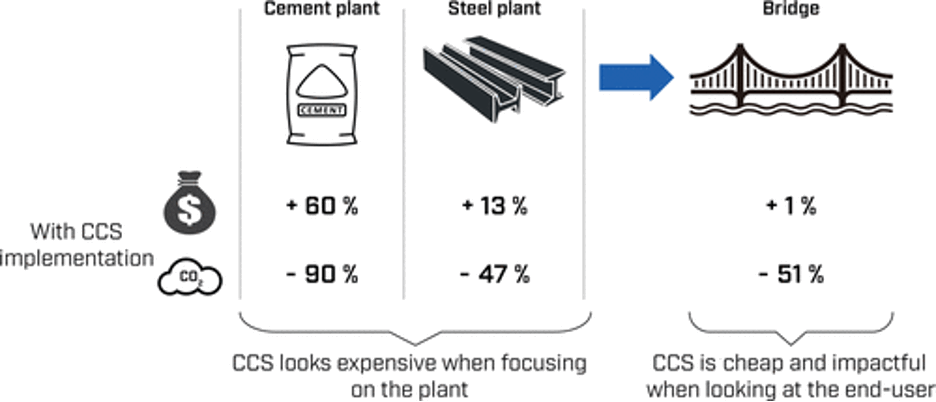Carbon Capture’s Surprisingly Affordable Twist: Steel and Cement’s Bridge to a Greener Future 51% carbon reduction for 1% cost increase.
In an enlightening new study, the presumed costliness of Carbon Capture and Storage (CCS) is challenged, revealing what industry professionals in the #steel and #cement sectors can no longer afford to overlook. The paper, penned by Subraveti et al. (2023), titled “Is Carbon Capture and Storage (CCS) Really So Expensive? An Analysis of Cascading Costs and CO2 Emissions Reduction of Industrial CCS Implementation on the Construction of a Bridge,” presents a compelling case for the adoption of CCS technologies.
A Marginal Cost for Monumental Change
The meticulous analysis in the study uncovers a revelation: the integration of CCS in the production of cement and steel might indeed escalate manufacturing costs – by 60% for cement and 13% for steel, respectively. However, when these figures trickle down to the actual construction cost of a bridge, the budget bloat is a mere 1%. It’s a small price tag, especially when weighed against the benefit of halving the CO2 emissions during the bridge’s construction.
The Misunderstood Economics of CCS This discovery serves as a critical recalibration of the cost narrative surrounding CCS. The study deftly illustrates that the augmented production costs associated with CCS are a drop in the ocean of total construction expenses. In the grand scheme, CCS’s ability to cut down emissions by 51% for just a 1% rise in construction costs demonstrates an economic finesse that has been overlooked for far too long.

Beyond the Bridge: The Implications for Industry The implications for the steel and cement industries are staggering. No longer can CCS be sidelined as a prohibitively expensive option. This study empowers industry leaders to view CCS as an essential, financially viable strategy in meeting global sustainability goals.
CarbonSig.com: The Modeling Maverick Enter CarbonSig – the digital tool capable of performing the type of nuanced carbon modeling that brings papers like Subraveti et al.’s to life. CarbonSig stands as a testament to how digital tools are revolutionizing our approach to sustainable industry practices. This powerful platform can dissect, analyze, and provide actionable insights, reinforcing the study’s findings and guiding companies on their journey to environmental stewardship.
Carbon Neutral bridges for an extra 4.75%
From the previous data provided, one asses the potential of Carbon Removal instruments to take things even further:
- CO2 emissions reduction due to CCS: 66,000 tons (ktonnes)
- Incremental cost due to CCS implementation: 3 million euros
- Original bridge construction cost without CCS: 379 million euros
Here’s the calculation for a $300/ton carbon cost if we were to create a carbon-neutral bridge using Carbon Removal instruments:
- Calculate the total carbon mitigation cost at $300/ton: Total Carbon Cost = CO2 Reduction * Carbon Cost per Ton Total Carbon Cost = 66,000 tons * $300/ton Total Carbon Cost = $19,800,000
- Convert the total carbon cost to euros (assuming the exchange rate is 1 euro = 1.1 US dollars): Total Carbon Cost in euros = $19,800,000 / 1.1 Total Carbon Cost in euros ≈ €18,000,000
- Calculate the percentage increase of the bridge cost due to the carbon cost: Percentage Increase = (Total Carbon Cost in euros / Original Bridge Cost without CCS) * 100 Percentage Increase = (€18,000,000 / €379,000,000) * 100 Percentage Increase ≈ 4.75%
Therefore, if there were a $300/ton carbon cost for mitigation, the cost impact on the total bridge would be an approximate 4.75% increase in construction costs. This scenario assumes that the carbon cost is an additional expense on top of the existing costs, including those for CCS implementation.
In Conclusion: CCS as an Investment in Our Planet The article by Subraveti et al. isn’t just a read; it’s a clarion call to the steel and cement industries. It beckons them towards an investment that is less about financial expenditure and more about committing to the planet’s future. With CarbonSig at the helm of carbon modeling, the path to sustainability is clearer and more attainable than ever before.